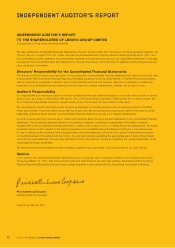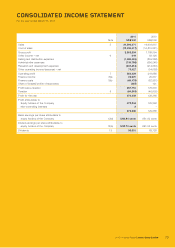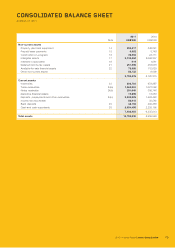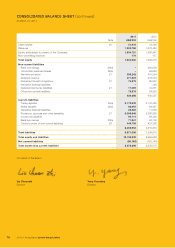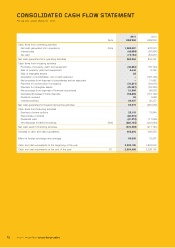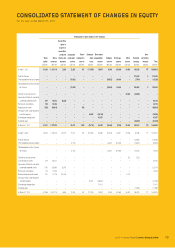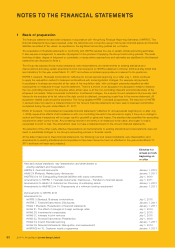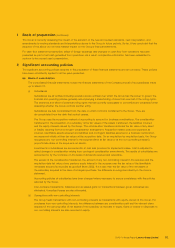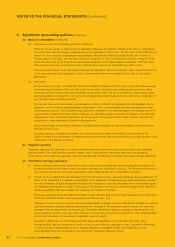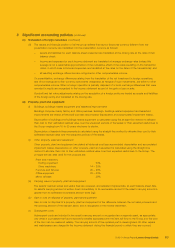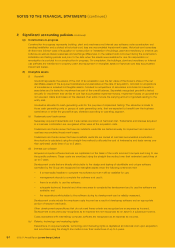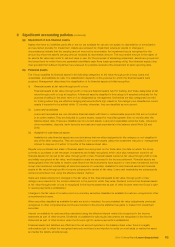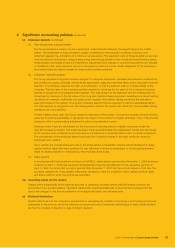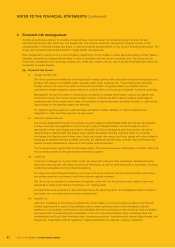Lenovo 2011 Annual Report Download - page 79
Download and view the complete annual report
Please find page 79 of the 2011 Lenovo annual report below. You can navigate through the pages in the report by either clicking on the pages listed below, or by using the keyword search tool below to find specific information within the annual report.
2010/11 Annual Report Lenovo Group Limited
82
NOTES TO THE FINANCIAL STATEMENTS (continued)
2 Significant accounting policies (continued)
(a) Basis of consolidation (continued)
(ii) Transactions with non-controlling interests (continued)
When the Group ceases to have control or significant influence, any retained interest in the entity is remeasured
to its fair value, with the change in carrying amount recognized in profit or loss. The fair value is the initial carrying
amount for the purposes of subsequent accounting for the retained interest as an associate, joint venture or
financial asset. In addition, any amounts previously recognized in other comprehensive income in respect of that
entity are accounted for as if the Group had directly disposed of the related assets or liabilities. This may mean
that amounts previously recognized in other comprehensive income are reclassified to profit or loss.
If the ownership interest in an associate is reduced but significant influence is retained, only a proportionate share
of the amounts previously recognized in other comprehensive income are reclassified to profit or loss where
appropriate.
(iii) Associates
An associate is an entity over which the Group has significant influence, but not control, generally accompanying
a shareholding of between 20% and 50% of the voting rights. Interests in associates are accounted for using
the equity method of accounting and are initially recognized at cost. The Group’s interests in associates include
goodwill identified on acquisition, net of any accumulated impairment losses. See note 2(g) for the impairment of
non-financial assets including goodwill.
The Group’s share of its associates’ post-acquisition profits or losses is recognized in the consolidated income
statement, and its share of post-acquisition movements in other comprehensive income is recognized in other
comprehensive income. The cumulative post-acquisition movements are adjusted against the carrying amount of
the investment. When the Group’s share of losses in an associate equals or exceeds its interest in the associate
including any other unsecured receivables, the Group does not recognize further losses, unless it has incurred
obligations or made payments on behalf of the associate.
Accounting policies of associates have been changed where necessary to ensure consistency with the policies
adopted by the Group.
Unrealized gains on transactions between the Group and its associates are eliminated to the extent of the
Group’s interest in the associates. Unrealized losses are eliminated unless the transaction provides evidence of an
impairment of the assets transferred.
(b) Segment reporting
Operating segments are reported in a manner consistent with the internal reporting provided to the chief operating
decision-maker. The chief operating decision-maker, who is responsible for allocating resources and assessing
performance of the operating segments, has been identified as the steering committee that makes strategic decisions.
(c) Translation of foreign currencies
(i) Items included in the financial statements of each of the Group’s entities are measured using the currency of the
primary economic environment in which the entity operates (the “functional currency”). The financial statements of
the Company and of the Group are presented in United States dollars (the “presentation currency”).
(ii) Foreign currency transactions are translated into the functional currency using the exchange rates prevailing at the
dates of the transactions or valuation where items are re-measured. Foreign exchange gains and losses resulting
from the settlement of such transactions and from the translation at year-end exchange rates of monetary assets
and liabilities denominated in foreign currencies are recognized in the income statement, except when deferred in
equity as qualifying cash flow hedges and qualifying net investment hedges.
All foreign exchange gains and losses that relate to bank deposits and cash and cash equivalents are presented in
the income statement within ‘other operating income/(expenses) – net’.
Changes in the fair value of monetary securities denominated in foreign currency classified as available-for-sale are
analyzed between translation differences resulting from changes in the amortized cost of the security and other
changes in the carrying amount of the security. Translation differences related to changes in the amortized cost
are recognized in profit or loss, and other changes in the carrying amount are recognized in other comprehensive
income and included in the investment revaluation reserve in equity.
Translation differences on non-monetary financial assets and liabilities such as equities held at fair value
through profit or loss are recognized in profit or loss as part of the fair value gain or loss. Translation differences
on non-monetary financial assets such as equities classified as available-for-sale are recognized in other
comprehensive income and included in the investment revaluation reserve in equity.


